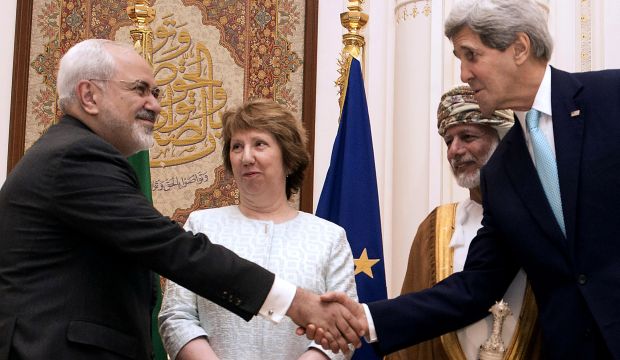
Iran nuclear talks: What absolute deadlines?
Dr. Majid Rafizadeh/Al Arabiya
Tuesday, 30 June 2015
For yet another time, a deadline for Iran’s nuclear talks has been missed. Other deadlines, including the ones set for July and November of 2014 were also missed and later extended. The six world powers and Iran also ignored the deadline to reach a general framework that was set for March 31, 2015. The next deadline of July 9 might not be a final deadline as well; it can also be extended till a deal is sealed. Iran wants the deal, and the U.S. appears to want it more. It seems that an absolute deadline is really not “absolute” nor a ”deadline” when it comes to the nuclear negotiations between the six world powers (known as the P5+1; China, France, Russia, the United Kingdom, and the United States, plus Germany) and the Islamic Republic. Both sides, particularly the United States and the Islamic Republic, have gradually deemphasized the importance of meeting the deadlines. The United States, has been quick to offer an extension for the missed deadlines in order to avoid the collapse and total failure of the nuclear talks altogether A key player, the United States, has been quick to offer an extension for the missed deadlines in order to avoid the collapse and total failure of the nuclear talks altogether. Nevertheless, it is crucial to point out that extensions have led to agreements at the end of the day.
De-emphasizing and missing the deadlines appears to be a result of concerted efforts by the United States and Iran to show their domestic constituents and the global community that both sides are taking the deal seriously by working on the agreement even past the deadline by working hard on the details and attempting to give less concessions.
The Islamic Republic is attempting not to reveal any desperation or underlying urges to clinch a final nuclear deal. This is due to the notion, from the Iranian leaders’ perspective, that they are likely to obtain more concessions by not showing their desperation for the final nuclear deal. Iranian Foreign Minister Mohammad Javad Zarif’s trip to Tehran in the last moment, which led to the missed deadline, seems to be an attempt to project that the Islamic Republic is not really in need of such a deal and it can walk away from the agreement at any time. The Islamic Republic is well-known for playing such bargaining games. If the recent history of blowing deadlines and later reaching an agreement prevail, both sides will likely reach a final nuclear deal this time.
What are the remaining issues?
First of all, all the crucial issues that the six world powers and the Islamic Republic discussed and negotiated in the last 19 months, will come to surface again. At this stage, both sides are required to nail down the details of the final nuclear deal based on the preliminary agreement which was reached in April 2015. Nevertheless, while the parties celebrated the preliminary agreement in April, it soon became clear that both sides concluded different interpretations from the preliminary deal. For the Islamic Republic, two crucial issues are the lifting of financial sanctions and the restrictions on inspections of Iran’s military sites. On the other hand, domestically speaking, the Obama administration is attempting to show that the administration did not give concessions to the Iranian leaders.
As the skeptics of the nuclear deal argue, Iran’s economy will be bolstered while its nuclear program will only be limited for few years. After the time limit, there will be no restriction on Iran. Iran will be allowed to pursue its nuclear program at full speed legitimately and shrink its break out capacity to zero. As President Obama pointed out in an interview with NPR, “what is a more relevant fear would be that in year 13, 14, 15, they have advanced centrifuges that can enrich uranium fairly rapidly, and at that point the breakout times would have shrunk almost down to zero.”
In other words, the agreement is totally a win deal for Iranian leaders.
Iran has the upper-hand
On the other hand, the first and foremost objective of the Islamic Republic is the lifting of economic sanctions. Although both sides agree that financial sanctions will be ultimately lifted after a final nuclear deal is reached, Iran’s Supreme Leader Ayatollah Ali Khamenei’s redline is the immediate lifting of sanctions after the deal is sealed. While Iran’s Supreme Leader Ayatollah Khamenei seemed inflexible when issued a redline and demanded the lifting of all economic sanctions as a condition, the Islamic Republic can show some flexibility by altering the interpretation of the supreme leader’s redline without damaging his credibility. In other words, the Islamic Republic can wait a few months until all the sanctions (particularly the ones on Iran’s oil and banking systems) are lifted.
Secondly, the next stumbling block is the issue of inspection of nuclear and military sites. Although both sides have agreed to some kind of monitoring process by inspectors from the International Atomic Energy Agency (IAEA), the underlying hurdle is the scope of inspection rather than the inspection per se. Iranian leaders are opposed to allowing some of their military sites, which are under suspicion to have operated nuclear activities, to be inspected. This was the second redline of Iran’s supreme leader. Nevertheless, both sides are likely to reach common ground in this respect as well. Ayatollah Khamenei’s redlines in the last 20 months since the nuclear talks were initiated are more tactical moves to bolster Iran’s negotiating team’s position in the nuclear talks. Such redlines are aimed at strengthening Iran’s nuclear team to obtain more concessions from the West. The deal is a good deal for Iran. In addition, Iran’s supreme leader would issue such redlines in order to project that the United States needs Iran- not vice versa. Being cognizant of President Obama’s desperation for obtaining a deal for his foreign policy legacy, Ayatollah Khamenei clearly pointed out in a recent speech that the United States needs Iran. The third issue is the scope of Iran’s nuclear enrichments and research in the 10-15 years of the agreement, and after the expiration of the agreement. As President Obama previously pointed out, Iran’s break-out capacity to build a nuclear bomb can come to zero by the end of the agreement. As a result, the question is how fast the Islamic Republic can head towards the break out capacity.
Finally, all the technical issues discussed in the last 19 months will come to the surface again in this last round of nuclear talks. Nevertheless, this does not necessarily mean that the gaps between Washington and Tehran are too deep to bridge.
In fact, signing a final deal is a political decision rather than a technical one. Since both Iran’s hardliners and President Obama view the nuclear deal as a good deal, the prospect of clinching a deal seems to be high.





















